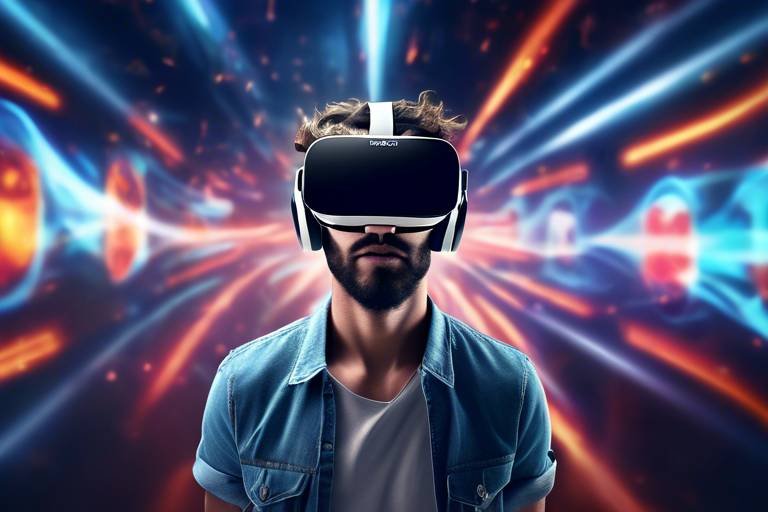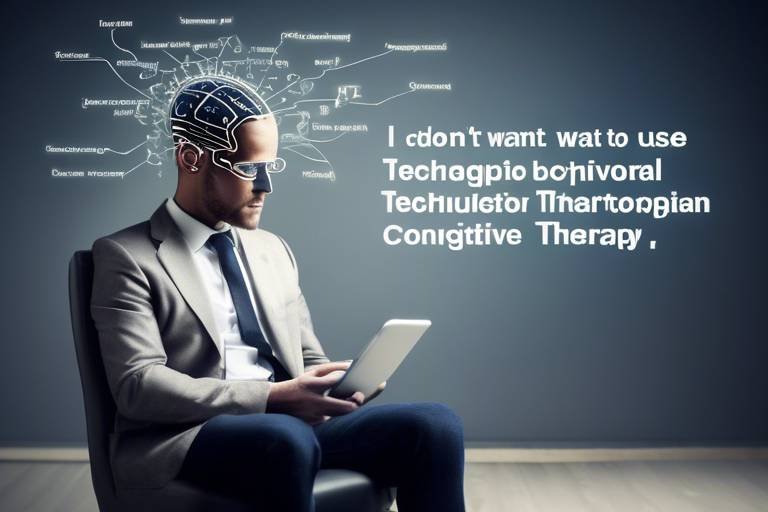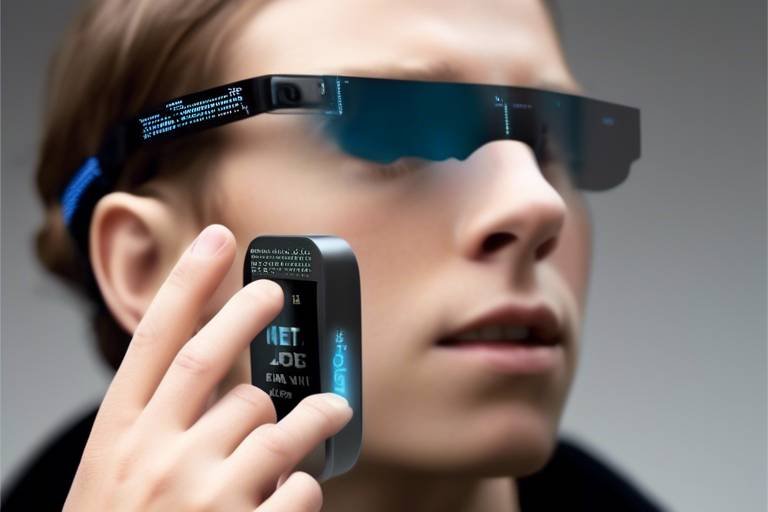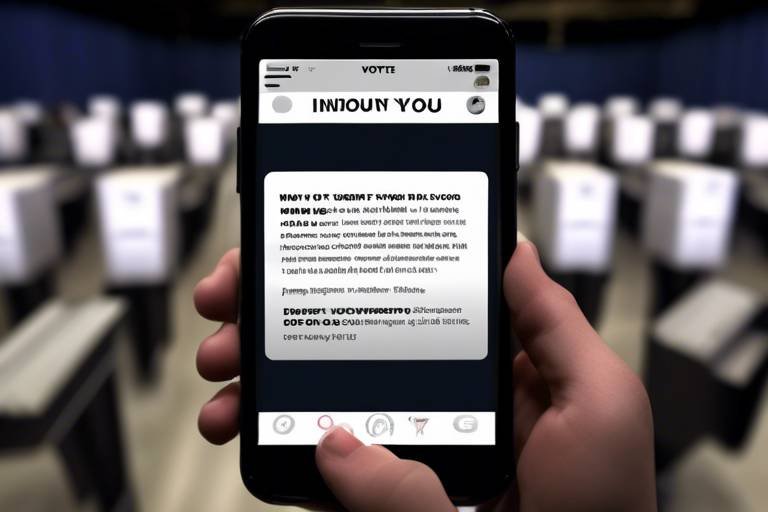The Next Wave of Virtual Reality - Trends to Watch
Virtual reality (VR) is not just a buzzword anymore; it's rapidly evolving into a transformative technology that is reshaping how we interact with digital content and each other. As we dive into the next wave of VR, it's essential to explore the emerging trends that are paving the way for a future filled with possibilities. From advancements in hardware to innovative applications across various industries, the landscape of VR is expanding at an unprecedented pace. Imagine stepping into a world where you can learn, work, and socialize in immersive environments that feel as real as your everyday life. This article will guide you through the exciting trends to watch in the realm of virtual reality, ensuring you're well-informed and ready to embrace the future.
One of the most significant drivers of virtual reality's growth is the continuous advancement in hardware. Today’s VR headsets are becoming more sophisticated, boasting high-resolution displays, improved graphics, and reduced latency. These enhancements create a more immersive and realistic experience for users. For instance, the latest headsets come equipped with eye-tracking technology, allowing for a more intuitive interaction with virtual environments. Furthermore, advancements in motion tracking are enabling users to move more freely and naturally within these spaces. As these technologies evolve, we can expect VR to become an integral part of our daily lives, blurring the lines between the digital and physical worlds.
While gaming has been the primary focus of VR, its applications are rapidly expanding into various industries. From education to healthcare and real estate, VR is revolutionizing how professionals train, engage, and connect. For example, in the real estate sector, virtual tours allow potential buyers to explore properties from the comfort of their homes, making the buying process more efficient. Similarly, in healthcare, VR is being utilized for patient treatment and surgical training, providing a safe environment for medical professionals to hone their skills. The versatility of VR technology is unlocking new possibilities, making it a valuable tool across multiple fields.
Educational institutions are increasingly adopting VR to create immersive learning experiences that captivate students' imaginations. Imagine a classroom where students can embark on virtual field trips to ancient civilizations or explore the depths of the ocean without leaving their seats. This innovative approach not only makes learning more engaging but also enhances retention by providing hands-on experiences. Additionally, VR is becoming a crucial tool for skill development training, allowing students and professionals to practice in a controlled environment. By simulating real-world scenarios, VR prepares learners for challenges they may face in their careers.
Virtual field trips are a game-changer in education, offering students the chance to visit historical sites, museums, and natural wonders without the logistical challenges of traditional field trips. These experiences can significantly enhance educational outcomes by providing context and engagement. However, while virtual field trips offer many benefits, they also come with limitations, such as the lack of physical interaction and sensory experiences that real-world trips provide. Balancing these aspects is crucial for maximizing the educational value of VR.
In fields such as aviation, medicine, and engineering, VR simulations are increasingly being used for skill development training. These simulations allow learners to practice tasks in a safe environment, making mistakes without real-world consequences. For instance, medical students can perform virtual surgeries, gaining invaluable experience before they ever step into an operating room. The effectiveness of VR in providing hands-on experience is reshaping how training is conducted, enabling a new generation of skilled professionals.
Healthcare professionals are harnessing the power of VR to improve patient treatment and enhance medical education. By simulating surgical procedures or patient interactions, VR can help practitioners refine their skills and prepare for real-life scenarios. Moreover, VR can also serve as a therapeutic tool for patients, helping them manage pain or anxiety through immersive distraction techniques. The potential of VR in healthcare is vast, paving the way for better patient outcomes and more effective training for medical professionals.
As social VR platforms gain traction, they are redefining how we interact with one another. Imagine attending a concert with friends from across the globe, all while experiencing the performance in a virtual environment that feels almost real. Social VR is creating new avenues for connection, allowing users to collaborate and communicate in ways that traditional social media cannot match. The ability to share experiences in immersive spaces fosters a sense of community and belonging, making social interactions more meaningful.
Virtual events are becoming a staple in the digital landscape, offering unique opportunities for conferences, concerts, and meetups. These events provide several advantages over traditional formats, such as reduced costs, increased accessibility, and the ability to connect with a global audience. For instance, a conference hosted in VR can accommodate thousands of participants, all interacting in real-time, regardless of their physical location. As more people embrace these experiences, the future of social gatherings will undoubtedly evolve.
Communities are forming around shared interests in virtual spaces, creating a sense of belonging that transcends geographical boundaries. Whether it's a group of gamers collaborating on a quest or professionals networking in a virtual office, VR fosters connections that might not be possible in the physical world. These immersive environments allow users to engage with one another, share ideas, and collaborate in ways that enhance creativity and innovation.
Artificial intelligence is playing a pivotal role in enhancing VR experiences. By personalizing content and improving user interactions, AI is making virtual environments more engaging and user-friendly. For example, AI can analyze user behavior to tailor experiences, ensuring that each individual feels a sense of ownership and connection to the virtual world. As AI continues to evolve, its integration with VR will lead to even more immersive and personalized experiences.
As VR technology advances, ethical considerations surrounding privacy, consent, and addiction become increasingly important. Developers and users alike must address these challenges to ensure responsible use of VR. For instance, as users immerse themselves in virtual environments, the potential for addiction or escapism raises concerns. Striking a balance between innovation and ethical responsibility will be crucial in shaping the future of VR.
The future of VR content creation is bright, with new tools and platforms emerging to facilitate development. As more creators enter the VR space, we can expect a surge of innovative content that pushes the boundaries of storytelling and interaction. This evolving landscape presents exciting opportunities for artists, educators, and developers to collaborate and create experiences that resonate with audiences on a deeper level.
Understanding market trends is essential for stakeholders in the VR industry. With increasing investment and interest from various sectors, the growth of virtual reality is expected to accelerate. Analysts predict that as technology becomes more accessible and affordable, adoption rates will soar, leading to a more significant presence of VR in everyday life. Keeping an eye on these trends will help businesses and individuals navigate the dynamic landscape of virtual reality.
Consumer adoption of VR technology is steadily increasing, driven by advancements in hardware and a growing array of applications. Factors such as affordability, ease of use, and compelling content are influencing user acceptance. As VR becomes more integrated into daily activities, from gaming to education and beyond, the potential for widespread adoption in the coming years is promising. The key will be to continue innovating and addressing user needs to ensure that VR remains an appealing option.
In conclusion, the future of virtual reality is filled with potential and innovation. As we explore the trends shaping this technology, it’s clear that VR is poised to revolutionize how we learn, work, and connect. By staying informed about these developments, enthusiasts and developers alike can embrace the VR revolution and harness its transformative power. So, are you ready to step into the future of virtual reality?
Q: What are the primary applications of virtual reality?
A: Virtual reality is used in various fields, including gaming, education, healthcare, real estate, and social interaction.
Q: How is VR transforming education?
A: VR creates immersive learning experiences, such as virtual field trips and skill development training, making education more engaging and effective.
Q: What role does artificial intelligence play in VR?
A: AI enhances VR experiences by personalizing content and improving user interactions, making virtual environments more engaging.
Q: What are the ethical considerations surrounding VR?
A: Ethical concerns include privacy, consent, and the potential for addiction, which developers and users must address for responsible use.

1. Advancements in Hardware
Recent advancements in VR hardware are nothing short of revolutionary, significantly enhancing user experiences and pushing the boundaries of what virtual reality can achieve. Imagine stepping into a world where graphics are so lifelike that you can almost feel the textures of the environment around you; this is the reality we are approaching. With the introduction of high-resolution displays, the visuals in virtual reality are becoming increasingly crisp and immersive, allowing users to lose themselves in the digital realm.
One of the most exciting developments is the reduction in latency. Latency, the delay between a user's action and the system's response, has long been a hurdle in creating a seamless VR experience. Thanks to advancements in processing power and optimization techniques, the lag that once disrupted immersion is rapidly diminishing. This means that when you turn your head, the visuals respond almost instantaneously, creating a more natural and engaging experience.
Moreover, tracking technology has seen significant improvements. Modern VR headsets now utilize advanced sensors and cameras that track movement with incredible precision. This allows for a more accurate representation of the user's physical movements in the virtual space, making experiences feel more real than ever. For instance, the introduction of inside-out tracking eliminates the need for external sensors, making it easier for users to set up and enjoy VR experiences without complicated installations.
Another noteworthy advancement is the development of haptic feedback devices. These gadgets provide tactile sensations that simulate touch and interaction within the virtual environment. Imagine feeling the vibration of a virtual explosion or the gentle breeze of a digital landscape; haptic feedback brings a whole new dimension to immersion. As these technologies continue to evolve, we can expect even more sophisticated ways to engage the senses.
To summarize, the future of VR hardware is bright, with innovations that promise to redefine how we interact with virtual environments. Here’s a quick table to highlight some of the key advancements:
| Advancement | Description |
|---|---|
| High-Resolution Displays | Enhances visual clarity and realism in virtual environments. |
| Reduced Latency | Minimizes lag, creating a seamless experience between user actions and system responses. |
| Improved Tracking Technology | Utilizes advanced sensors for accurate movement representation. |
| Haptic Feedback Devices | Provides tactile sensations to simulate touch and interaction. |
As we embrace these advancements, it’s essential to recognize their potential to transform not just gaming, but various sectors such as education, healthcare, and beyond. Each leap in technology opens up new possibilities for developers and users alike, paving the way for a future where VR becomes an integral part of our daily lives. So, are you ready to dive into this new wave of virtual reality?

2. Expanding Applications in Industries
Virtual reality (VR) is not just a playground for gamers anymore; it’s rapidly becoming a transformative force across various sectors. The technology has evolved beyond its initial entertainment roots and is now making significant inroads into industries like education, healthcare, and real estate. This shift is not only enhancing operational efficiencies but also providing more engaging and effective solutions to age-old challenges. Imagine a world where students can step into the shoes of historical figures, or where surgeons can practice complex procedures without any risk to patients. This is the reality that VR is creating, and the possibilities are endless.
In education, for instance, VR is revolutionizing how knowledge is imparted. Traditional learning methods often lack the engagement that modern students crave. With VR, educators can create immersive learning environments that capture students' attention and foster deeper understanding. By simulating real-world scenarios, students can apply what they learn in practical contexts, making the educational experience not just informative, but also enjoyable. For example, a student studying marine biology can explore the depths of the ocean without ever getting wet!
Moreover, the healthcare sector is witnessing a remarkable transformation thanks to VR. Medical professionals are utilizing VR for both patient treatment and surgical training. Imagine a surgeon practicing a complex operation in a virtual environment before stepping into the operating room. This not only boosts their confidence but also enhances their skills, ultimately leading to better patient outcomes. Furthermore, VR is being used in therapy settings, helping patients overcome phobias or anxiety disorders by gradually exposing them to their fears in a controlled environment.
Real estate is another industry where VR is making waves. Gone are the days when potential buyers had to physically visit every property. With VR, they can take virtual tours of homes from the comfort of their couch. This not only saves time but also allows buyers to explore multiple properties in a short span of time. Real estate agents are leveraging this technology to provide immersive experiences that help clients visualize spaces better, making the buying process more efficient and enjoyable.
As we dive deeper into the applications of VR, it's clear that this technology is reshaping industries in ways we never thought possible. The impact is profound, and as innovations continue to emerge, we can only anticipate even more groundbreaking applications. The question remains: how will your industry adapt to this virtual revolution?
Q: What industries are currently using VR technology?
A: Industries such as education, healthcare, real estate, and entertainment are currently leveraging VR technology to enhance their operations and user experiences.
Q: How does VR improve learning in education?
A: VR creates immersive environments that engage students more effectively, allowing them to experience scenarios and concepts in a practical context, which enhances understanding and retention.
Q: Can VR be used for training in healthcare?
A: Yes, VR is extensively used in healthcare for surgical training and patient treatment, allowing professionals to practice procedures in a risk-free environment.
Q: How is VR changing the real estate market?
A: VR allows potential buyers to take virtual tours of properties, making the home-buying process more efficient by saving time and providing a better understanding of the space.

2.1. VR in Education
Virtual reality (VR) is revolutionizing the educational landscape, transforming traditional classrooms into dynamic learning environments. Imagine stepping into a world where you can explore ancient civilizations, dissect a virtual frog, or even travel through the human body—all without leaving your classroom! This is the power of VR in education, and it's changing the way students engage with content.
One of the most exciting aspects of VR in education is its ability to create immersive learning experiences. Students can participate in virtual field trips that allow them to visit historical landmarks or natural wonders from the comfort of their desks. These experiences are not just about sightseeing; they provide context and depth to the subjects being studied. For instance, a history lesson about the pyramids of Egypt can be greatly enhanced by allowing students to explore a 3D model of the site, understanding its architecture and cultural significance in a way that textbooks simply cannot convey.
Additionally, VR offers incredible opportunities for skill development training. In fields such as medicine, engineering, and even the arts, VR simulations can provide hands-on experience in a safe and controlled environment. For example, medical students can practice surgical procedures on virtual patients, honing their skills without the risk associated with real-life operations. This method of training not only boosts confidence but also prepares students for real-world challenges they will face in their respective careers.
However, it's essential to acknowledge that while VR has immense potential, there are also limitations to consider. Access to VR technology can be a barrier for some educational institutions, particularly in underfunded areas. Moreover, the effectiveness of VR as a teaching tool depends heavily on the quality of the content and the training provided to educators. Schools must invest in both technology and teacher training to truly harness the benefits of VR.
In conclusion, the integration of VR into education is not just a trend; it's a paradigm shift that promises to make learning more engaging, interactive, and effective. As technology continues to evolve, we can expect to see even more innovative applications of VR in classrooms around the world, paving the way for future generations of learners.
- What is VR in education? VR in education refers to the use of virtual reality technology to create immersive learning experiences that enhance student engagement and understanding.
- How does VR improve learning outcomes? By providing interactive and immersive experiences, VR can help students retain information better and develop practical skills in a safe environment.
- Are there any challenges to implementing VR in schools? Yes, challenges include the cost of technology, access disparities among schools, and the need for teacher training to effectively use VR tools.
- What subjects can benefit from VR? Subjects like history, science, and even art can greatly benefit from VR experiences, making complex concepts easier to understand.

2.1.1. Virtual Field Trips
Imagine stepping into the shoes of a historian, wandering the ancient streets of Rome or standing in awe before the Great Wall of China, all without leaving your classroom. Virtual field trips are revolutionizing the way students experience learning by transporting them to places they've only read about in textbooks. These immersive experiences not only make education more engaging but also provide a unique opportunity to explore diverse cultures and environments in a way that was previously unimaginable.
One of the most significant advantages of virtual field trips is their ability to break down geographical barriers. Students can visit landmarks, museums, and even natural wonders from the comfort of their own desks. This accessibility opens up a world of possibilities for educational institutions, allowing them to offer experiences that might be logistically or financially challenging in the real world.
However, while virtual field trips offer incredible benefits, they also come with limitations. For instance, the lack of physical presence means students miss out on sensory experiences like the smell of the ocean or the sound of bustling city streets. Additionally, not all students may have equal access to the technology required for these trips, potentially widening the educational gap.
To maximize the effectiveness of virtual field trips, educators can incorporate them into a broader curriculum. For example, after a virtual visit to the Louvre, teachers can encourage students to create art projects inspired by what they saw. This integrative approach reinforces learning and allows students to express their understanding creatively.
In conclusion, virtual field trips are a fantastic tool for enhancing education, making learning more interactive and engaging. As technology continues to advance, the experiences offered by virtual field trips will only become more realistic and impactful, paving the way for a future where learning knows no bounds.
- What technology is needed for virtual field trips? Typically, a VR headset or a computer with internet access is required, along with specific software or applications designed for virtual experiences.
- Are virtual field trips suitable for all age groups? Yes, virtual field trips can be tailored to suit various age groups, making them a versatile educational tool.
- How do virtual field trips enhance learning? They provide immersive experiences that can increase engagement, retention, and understanding of complex subjects.
- Can virtual field trips replace traditional field trips? While they offer unique benefits, they are best used as a complement to traditional field trips rather than a complete replacement.

2.1.2. Skill Development Training
In today's rapidly evolving job market, skill development training is more crucial than ever. Virtual reality (VR) has emerged as a game-changer in this arena, providing immersive environments that simulate real-world scenarios. Imagine stepping into a virtual factory where you can practice operating machinery without the risk of injury, or entering a virtual classroom where you can engage in complex problem-solving exercises with peers from around the globe. These experiences not only enhance learning but also significantly boost retention rates.
One of the most compelling aspects of VR for skill development is its ability to create a safe and controlled environment. Trainees can make mistakes and learn from them without the consequences that would occur in a real-life setting. This is particularly beneficial in high-stakes industries such as healthcare, aviation, and manufacturing. For instance, a medical student can perform virtual surgeries, honing their skills before they ever touch a scalpel on a real patient. Similarly, pilots can practice emergency procedures in flight simulators that replicate various scenarios they may encounter in the air.
Furthermore, VR training programs can be tailored to meet the specific needs of different learners. This personalization is achieved through the integration of artificial intelligence, which can analyze a trainee's performance and adjust the difficulty level accordingly. For example, if a trainee struggles with a particular task, the VR system can provide additional practice or alternative learning resources, ensuring that each individual receives the support they need to succeed.
To illustrate the effectiveness of VR in skill development, consider the following table that compares traditional training methods with VR-based training in various industries:
| Industry | Traditional Training | VR-Based Training |
|---|---|---|
| Healthcare | Shadowing experienced professionals | Virtual surgeries and patient interactions |
| Aviation | Flight simulators | Immersive flight scenarios with real-time feedback |
| Manufacturing | On-the-job training | Simulated assembly line operations |
As we look to the future, the potential for VR in skill development training is enormous. Organizations are beginning to recognize the advantages of incorporating VR into their training programs, not just for enhancing skills but also for improving employee engagement and satisfaction. With the ability to track progress and outcomes through detailed analytics, companies can ensure their training investments yield significant returns.
In conclusion, VR is revolutionizing skill development training by providing immersive, engaging, and safe learning experiences. As technology continues to advance, we can expect even more innovative applications that will help individuals acquire the skills they need to thrive in their careers. The question remains: are you ready to embrace this new frontier of learning?
- What types of skills can be developed using VR? VR can be used to develop a wide range of skills, including technical skills in fields like healthcare, aviation, and manufacturing, as well as soft skills such as communication and teamwork.
- Is VR training effective? Yes, studies have shown that VR training can lead to higher retention rates and improved performance compared to traditional training methods.
- How does VR personalize the learning experience? VR systems can utilize AI to analyze a trainee's performance and adjust the difficulty and content to better suit their learning pace and style.

2.2. VR in Healthcare
Virtual reality (VR) is revolutionizing the healthcare industry in ways we could only dream of a few years ago. Imagine stepping into a 3D simulation where you can practice surgical procedures without any risk to real patients. This is not just a fantasy; it's a reality that is enhancing training for healthcare professionals and improving patient care. With the development of sophisticated VR technologies, medical practitioners are now able to gain invaluable experience in a controlled environment, which significantly boosts their confidence and skill set.
One of the most exciting applications of VR in healthcare is its use in patient treatment. For instance, VR is being utilized to help patients manage pain, anxiety, and phobias. By immersing patients in calming virtual environments, healthcare providers can distract them from pain or anxiety during medical procedures. This approach not only enhances the overall patient experience but also reduces the need for medication, leading to fewer side effects and a quicker recovery time.
Additionally, VR is making waves in rehabilitation therapy. Patients recovering from strokes or injuries can engage in tailored VR exercises that are both motivating and fun. This gamified approach encourages participation, making rehabilitation feel less like a chore and more like an engaging activity. The ability to track progress in real-time also allows therapists to adjust treatment plans based on the patient's needs.
Here are some notable applications of VR in healthcare:
- Surgical Training: Surgeons can practice complex procedures in a risk-free setting, honing their skills before operating on real patients.
- Patient Education: VR can help patients visualize their conditions and treatment options, leading to better understanding and cooperation.
- Exposure Therapy: For patients with phobias or PTSD, VR can simulate triggering environments in a controlled way, helping them confront and overcome their fears.
In summary, the integration of VR in healthcare is not just about technology; it's about transforming lives. As we continue to explore and expand these applications, the potential for improved patient outcomes and enhanced training for healthcare professionals is limitless. The excitement surrounding VR in healthcare is palpable, and it’s paving the way for a future where treatment is more effective, engaging, and accessible.
Q: How is VR used in surgical training?
A: VR provides a realistic simulation environment where surgeons can practice procedures, refine their skills, and gain confidence without the risk of harming patients.
Q: Can VR help with pain management?
A: Yes, VR can distract patients from pain by immersing them in calming virtual environments, thereby reducing the need for pain medication.
Q: What are the benefits of using VR for rehabilitation?
A: VR makes rehabilitation more engaging and motivating for patients, allowing them to participate in tailored exercises while tracking their progress in real-time.

3. Social Interaction in Virtual Reality
Virtual reality (VR) is not just about immersive gaming experiences; it's also revolutionizing the way we interact socially. Imagine stepping into a digital world where you can meet friends, attend events, or collaborate on projects, all from the comfort of your home. This new frontier of social interaction is reshaping our connections and experiences in profound ways. As VR technology continues to advance, it is creating opportunities for users to engage in ways that were previously unimaginable.
One of the most exciting aspects of social VR is the ability to participate in virtual events. These gatherings can range from concerts and conferences to casual meetups. Unlike traditional formats, virtual events offer a unique blend of accessibility and engagement. Participants can join from anywhere in the world, eliminating geographical barriers and making it easier to connect with like-minded individuals. Imagine attending a concert where you can see your favorite band perform live, yet also interact with fans from other continents. This level of connectivity is transforming the way we experience entertainment.
Moreover, social VR platforms are fostering the development of communities around shared interests. Whether it’s gaming, art, or education, users can gather in virtual spaces to collaborate, share ideas, and create together. These communities not only enhance the social aspect of VR but also provide a sense of belonging. In a world where people often feel isolated, VR communities can act as a lifeline, bringing individuals together in meaningful ways.
However, the rise of social interaction in VR comes with its own set of challenges. Issues such as privacy, consent, and the potential for addiction must be addressed. Users often share personal information in these immersive environments, making it crucial for developers to prioritize user safety and ethical considerations. As we navigate this new landscape, it’s essential to find a balance between innovation and responsibility.
In conclusion, social interaction in virtual reality is paving the way for a new era of connectivity. With the ability to attend virtual events and build communities, VR is not just a tool for entertainment; it’s a platform for social engagement. As we embrace this technology, let’s also remain vigilant about the ethical implications and strive to create a safe and inclusive virtual world for everyone.
- What are social VR platforms?
Social VR platforms are virtual environments where users can interact with each other in real-time, often through avatars. Examples include VRChat, AltspaceVR, and Rec Room.
- Can I attend events in VR?
Yes! Many social VR platforms host events like concerts, conferences, and meetups that you can attend virtually.
- How does privacy work in social VR?
Privacy in social VR varies by platform. It's important to review the privacy settings and policies of the platform you choose to ensure your information is safe.
- Is social VR safe for children?
While many social VR platforms have age restrictions, parental guidance is recommended to ensure a safe experience for younger users.

3.1. Virtual Events and Gatherings
In recent years, virtual events and gatherings have taken the world by storm, transforming the way we connect and interact. Imagine attending a conference from the comfort of your living room or joining a concert in a vibrant digital world. This shift has not only made events more accessible but has also opened up a plethora of opportunities for engagement and collaboration.
One of the most exciting aspects of virtual events is the ability to connect with people from all over the globe. No longer are we limited by geographical boundaries; instead, we can network with industry leaders, attend workshops, and participate in discussions with like-minded individuals, all in real-time. The immersive nature of virtual reality enhances these interactions, making them feel more personal and impactful.
Moreover, virtual events often come with unique features that enhance the experience. For example, attendees can:
- Explore interactive booths and exhibits
- Participate in live Q&A sessions
- Engage in breakout discussions with experts
- Network through virtual lounges and chat rooms
These features not only make the events more engaging but also foster a sense of community among participants. Imagine walking through a virtual expo hall, stopping by various booths, and chatting with representatives as if you were physically present. The possibilities are endless!
Another significant advantage of virtual events is their cost-effectiveness. Organizers can save on venue rentals, catering, and travel expenses, allowing them to allocate resources to enhance the event's quality. This, in turn, can lead to lower ticket prices for attendees, making events more affordable and accessible to a broader audience.
However, it's essential to acknowledge some challenges that come with virtual gatherings. Technical difficulties, such as connectivity issues or software glitches, can disrupt the flow of an event. Furthermore, the lack of physical presence may lead to feelings of isolation for some participants. Nevertheless, as technology continues to evolve, these challenges are being addressed, paving the way for even more seamless virtual experiences.
Looking ahead, the future of virtual events and gatherings seems bright. With advancements in technology, we can expect even more immersive experiences, such as enhanced 3D environments and the integration of artificial intelligence to personalize attendee experiences. As we embrace this new era of connectivity, virtual events will undoubtedly become a staple in our social and professional lives.
Q1: What types of virtual events can I attend?
A1: You can attend a variety of virtual events, including conferences, trade shows, workshops, concerts, and networking meetups.
Q2: Do I need special equipment to participate in virtual events?
A2: While a computer or smartphone is typically sufficient, having a VR headset can enhance your experience, especially for events designed for virtual reality.
Q3: How do I ensure a good experience at a virtual event?
A3: Make sure you have a stable internet connection, familiarize yourself with the event platform, and engage actively with other participants to make the most of the experience.

3.2. Building Communities in VR
In the ever-evolving landscape of virtual reality, one of the most exciting developments is the emergence of vibrant communities that flourish within these digital realms. Just like how a bustling neighborhood brings people together, VR is creating unique spaces where individuals can connect, collaborate, and share experiences, regardless of their physical locations. Imagine stepping into a virtual café where you can chat with friends from around the globe, or joining a virtual art gallery showcasing the work of talented creators from different countries. This is the magic of VR communities!
These communities are not just about socializing; they also foster collaboration and creativity. Users can come together to participate in events, workshops, and projects that leverage the immersive power of VR. For instance, artists can collaborate on virtual installations, musicians can perform live concerts, and gamers can form teams to tackle challenges together. The possibilities are truly endless!
Moreover, VR communities often revolve around shared interests and passions. Whether it's gaming, art, education, or wellness, these spaces cater to a variety of niches, allowing users to find their tribe. Within these communities, members can:
- Attend virtual meetups and events that align with their interests.
- Engage in discussions and share insights on topics they are passionate about.
- Collaborate on projects that can be showcased within the VR platform.
However, building a successful community in VR is not without its challenges. Developers must ensure that these spaces are welcoming and inclusive, promoting a sense of belonging for all users. Additionally, moderation is crucial to maintain a positive environment, preventing harassment and negativity that can often plague online interactions.
As we look to the future, the potential for VR communities is immense. With advancements in technology, we may see even more sophisticated platforms that allow for greater interaction and engagement. Imagine a world where you can attend a virtual conference, network with professionals, and even participate in hands-on workshops—all from the comfort of your own home!
In conclusion, building communities in virtual reality is a transformative experience that not only enhances social interaction but also fosters collaboration and creativity. As these communities continue to grow, they will play an essential role in shaping the future of how we connect and engage with one another in the digital age.
Q: How do I join a VR community?
A: Joining a VR community typically involves creating an account on a VR platform and exploring various groups or events that align with your interests. Many platforms offer dedicated spaces for users to connect.
Q: Are VR communities safe?
A: While many VR communities strive to create safe and inclusive environments, it's essential to be cautious and aware of the platform's moderation policies. Always report any inappropriate behavior.
Q: Can I create my own VR community?
A: Absolutely! Many VR platforms allow users to create their own spaces or groups, where you can invite others to join and participate in activities that interest you.

4. The Role of Artificial Intelligence
Artificial Intelligence (AI) is not just a buzzword; it’s a game-changer in the realm of Virtual Reality (VR). Imagine stepping into a world where your every move is met with instant feedback and personalized experiences. That’s the magic AI brings to the table. With the integration of AI, VR is evolving from simple simulations to dynamic environments that adapt to user behavior, preferences, and needs. This transformation is redefining how users interact with virtual spaces, making experiences not only more immersive but also tailored to individual users.
One of the most exciting aspects of AI in VR is its ability to enhance user interactions. For instance, AI algorithms can analyze user data to create responsive environments. If you’re exploring a virtual museum, AI can adjust the information displayed based on your interests. Are you fascinated by ancient artifacts? The system might highlight relevant exhibits or provide deeper insights into those items. This level of personalization ensures that users remain engaged and invested in their virtual experiences.
Moreover, AI can also play a pivotal role in creating intelligent virtual companions. These companions can learn from user interactions, providing a more human-like experience. Imagine having a virtual guide that not only knows the history of a place but also understands your preferences and can engage in meaningful conversations. This not only enhances the immersion but also fosters a sense of connection within the virtual world.
In addition to enhancing user experience, AI is revolutionizing content creation in VR. Developers can leverage AI tools to generate realistic environments and characters, significantly reducing the time and resources required for development. For example, procedural generation techniques powered by AI can create expansive landscapes or intricate cityscapes with minimal human input. This allows creators to focus on storytelling and user engagement rather than getting bogged down by technical limitations.
However, the integration of AI in VR isn’t without its challenges. As we embrace these advancements, it’s crucial to consider the ethical implications. Issues surrounding privacy, data security, and algorithmic bias must be addressed to ensure that users feel safe and respected in these virtual spaces. Developers and stakeholders need to work collaboratively to establish guidelines that promote responsible AI use in VR environments.
In summary, the role of AI in virtual reality is multifaceted and transformative. From enhancing user experiences to streamlining content creation, AI is paving the way for a more interactive and personalized VR landscape. As this technology continues to evolve, it’s essential for both users and developers to stay informed and engaged in discussions about its ethical use.
- How does AI improve user experience in VR?
AI enhances user experience by personalizing interactions, adapting environments to user preferences, and creating intelligent virtual companions that provide meaningful engagement.
- What are the ethical concerns related to AI in VR?
Ethical concerns include privacy issues, data security, and the potential for algorithmic bias, which need to be addressed to ensure safe and respectful user experiences.
- Can AI assist in VR content creation?
Yes, AI can significantly streamline the content creation process by generating realistic environments and characters, allowing developers to focus on storytelling and user engagement.

5. Ethical Considerations and Challenges
As we plunge deeper into the realm of virtual reality (VR), we must take a moment to pause and reflect on the ethical considerations that accompany this transformative technology. The rapid advancement of VR raises several critical questions regarding privacy, consent, and even the potential for addiction. Just as a double-edged sword can both defend and harm, VR holds the power to enhance our experiences while simultaneously posing significant ethical dilemmas.
One of the foremost concerns revolves around privacy. VR experiences often require extensive data collection, including users' physical movements, locations, and even biometric information. This data can be incredibly sensitive, and if mishandled, it could lead to breaches of privacy that users may not even be aware of. Imagine stepping into a virtual world where every action is monitored and recorded. How comfortable would you feel knowing that your movements and interactions are being scrutinized? The challenge lies in ensuring that data is collected transparently and stored securely, without infringing on users' rights.
Another pressing issue is the question of consent. In many VR applications, users are required to agree to terms of service that are often lengthy and filled with legal jargon. How many of us actually read these agreements? The reality is that many users may unknowingly consent to practices they are uncomfortable with, such as the sharing of their data with third parties. Developers and companies must prioritize clear communication and informed consent, ensuring that users fully understand what they are agreeing to before they dive into the virtual experience.
The potential for addiction is yet another challenge that cannot be overlooked. VR can create highly immersive environments that are incredibly engaging, leading some users to spend excessive amounts of time within these digital realms. The line between healthy engagement and addiction can easily blur, raising concerns about the impact on mental health and real-world relationships. It’s crucial for developers to incorporate features that promote healthy usage patterns, encouraging breaks and moderation to mitigate the risk of addiction.
To tackle these ethical challenges effectively, stakeholders in the VR industry must come together to establish guidelines and best practices. Here are some key areas to focus on:
- Data Protection: Implement robust data security measures and transparency in data collection practices.
- Informed Consent: Simplify terms of service and ensure users understand what they are consenting to.
- Usage Monitoring: Develop tools to help users track their VR usage and encourage responsible engagement.
By addressing these ethical considerations, we can pave the way for a more responsible and enjoyable VR landscape. As we navigate this brave new world, it’s essential to keep the conversation going about the implications of our technological advancements. After all, the goal of VR should be to enhance our lives, not complicate them.
- What are the main ethical concerns regarding VR? The primary concerns include privacy, consent, and the potential for addiction.
- How can developers ensure user privacy? Developers should implement strong data protection measures and be transparent about data collection practices.
- What steps can be taken to prevent VR addiction? Features that promote healthy usage patterns, such as reminders to take breaks, can help mitigate the risk of addiction.

6. The Future of VR Content Creation
As we gaze into the crystal ball of virtual reality, one thing is clear: the future of VR content creation is not just bright; it's dazzling! With technology evolving at a breakneck pace, creators are equipped with tools that were once the stuff of science fiction. Imagine a world where anyone, from seasoned developers to enthusiastic hobbyists, can craft immersive experiences that transport users to new realms. This democratization of content creation is paving the way for a creative explosion in the VR space.
One of the most exciting advancements is the emergence of user-friendly platforms that allow creators to build VR content without needing extensive programming knowledge. Tools like Unity and Unreal Engine are becoming more accessible, featuring intuitive interfaces and robust libraries of assets. This shift is akin to how desktop publishing revolutionized the world of print media; suddenly, anyone with a computer could create professional-looking materials. Similarly, VR content creation is becoming a playground for imagination, where the only limit is one's creativity.
Moreover, the rise of collaborative VR environments is set to transform how content is developed. Imagine a group of artists and designers from different corners of the globe coming together in a virtual space to brainstorm, prototype, and refine their ideas in real-time. This collaborative spirit not only enhances creativity but also fosters a sense of community among creators. As VR technology continues to evolve, we can expect to see more platforms that support this kind of teamwork, making the creation process more dynamic and inclusive.
In addition to collaborative tools, the integration of AI-driven technologies into VR content creation is another game-changer. AI can assist in various ways, from generating realistic environments to providing personalized user experiences. For instance, imagine an AI that learns a user's preferences and tailors the VR environment accordingly, making each experience unique. This level of personalization can significantly enhance user engagement, making them feel more connected to the content.
However, with great power comes great responsibility. As the tools for VR content creation become more advanced, ethical considerations will arise. Developers must navigate issues such as content ownership, user privacy, and the potential for misuse of technology. It is crucial for the VR community to establish guidelines that promote responsible content creation while encouraging innovation.
To summarize, the future of VR content creation is poised for an exciting transformation. With advancements in technology, collaboration, and AI, the landscape is ripe for innovation. As we move forward, it will be essential for creators to embrace these changes while remaining mindful of the ethical implications. The possibilities are endless, and the next wave of VR content is just around the corner, ready to captivate audiences in ways we've only begun to imagine.
- What tools are available for VR content creation?
There are several tools available, including Unity, Unreal Engine, and Blender, which allow for the creation of immersive VR experiences. - How can I start creating VR content?
Begin by familiarizing yourself with VR development platforms and tutorials available online. Start small and gradually build your skills. - What are the ethical considerations in VR content creation?
Creators should be mindful of user privacy, content ownership, and potential misuse of technology while developing VR experiences. - Is AI involved in VR content creation?
Yes, AI can enhance the creation process by offering personalized experiences and generating realistic environments.

7. Market Trends and Predictions
The virtual reality (VR) market is experiencing a significant transformation, with trends that are not just reshaping the technology itself but also redefining how we interact with digital content. As we step into this new era, it's essential to grasp the current market dynamics and the predictions that industry experts are making. With a projected growth rate of over 30% annually, the VR market is poised to reach a staggering value of $57 billion by 2027. This explosive growth is fueled by advancements in hardware, software, and an expanding array of applications.
One of the most notable trends is the increasing integration of VR with other emerging technologies, such as artificial intelligence (AI) and augmented reality (AR). This convergence is creating more immersive experiences, allowing users to interact with virtual environments in ways that were previously unimaginable. For instance, AI can analyze user behavior and preferences, tailoring experiences to individual needs. This personalization not only enhances user engagement but also increases the likelihood of consumer adoption.
Moreover, the demand for VR in various sectors is on the rise. Industries such as healthcare, education, and real estate are leveraging VR technology to improve training, simulations, and customer experiences. Companies are increasingly recognizing the potential of VR to deliver value, leading to greater investment in VR solutions. For example, in education, institutions are adopting VR for immersive learning, while healthcare providers are using it for training and therapy.
To illustrate the market landscape, consider the following table that highlights key sectors driving VR growth:
| Sector | Market Value (2027) | Growth Rate |
|---|---|---|
| Gaming | $22 billion | 35% |
| Healthcare | $12 billion | 28% |
| Education | $10 billion | 30% |
| Real Estate | $5 billion | 25% |
As we look ahead, several predictions stand out. First, the consumer market for VR is expected to broaden significantly, with more affordable headsets and a wider variety of content becoming available. This democratization of VR technology will likely lead to increased usage in homes, schools, and workplaces.
Second, the rise of social VR platforms will transform how people connect and collaborate. Imagine attending a virtual concert with friends from around the world or participating in a global conference without ever leaving your living room. The potential for social interaction in VR is limitless, and as these platforms evolve, they will create new opportunities for community building and engagement.
Lastly, as VR technology becomes more mainstream, ethical considerations will come to the forefront. Issues related to privacy, data security, and user consent will need to be addressed as developers and users navigate this new landscape. Ensuring responsible use of VR will be crucial for its long-term success and acceptance.
In summary, the VR market is on the cusp of a revolution, driven by technological advancements and an expanding array of applications across various sectors. By staying informed about these trends and predictions, stakeholders can better position themselves to capitalize on the opportunities that lie ahead.
- What are the primary industries adopting VR technology? Industries such as gaming, healthcare, education, and real estate are leading the way in VR adoption.
- How fast is the VR market expected to grow? The VR market is projected to grow at a rate of over 30% annually, potentially reaching $57 billion by 2027.
- What role does AI play in VR? AI enhances VR experiences by personalizing content and improving user interactions based on behavior and preferences.
- What ethical considerations are associated with VR? Key issues include privacy, data security, and user consent that need to be addressed as VR technology becomes more prevalent.

8. Consumer Adoption Rates
The landscape of virtual reality (VR) is evolving rapidly, and one of the most telling indicators of its growth is the rate at which consumers are adopting this technology. As we dive deeper into the world of VR, it becomes increasingly clear that consumer adoption is not just a trend; it's a movement. But what exactly is driving this surge in interest? Several factors contribute to the increasing acceptance of VR technology among consumers.
Firstly, the declining costs of VR hardware play a significant role in this adoption. Just a few years ago, high-quality VR headsets were prohibitively expensive for the average consumer. However, with advancements in technology and increased competition among manufacturers, prices have dropped significantly. This affordability has made VR more accessible to a broader audience, allowing more people to experience the immersive worlds that VR has to offer.
Moreover, the availability of high-quality content is another crucial factor. With an expanding library of games, educational programs, and immersive experiences, consumers are finding compelling reasons to invest in VR. From thrilling adventures in gaming to educational tools that enhance learning, the variety of content available is staggering. According to recent studies, over 70% of VR users cite the availability of engaging content as a primary reason for their purchase.
Additionally, social acceptance of VR technology is on the rise. As more people share their experiences on social media and in their personal networks, word-of-mouth becomes a powerful tool for driving interest. When friends and family rave about their VR experiences, it piques curiosity and encourages others to explore the technology themselves.
To illustrate the current consumer adoption rates and trends, let’s take a look at the following table:
| Year | Estimated Global VR Users (in millions) | Growth Rate (%) |
|---|---|---|
| 2018 | 6.5 | N/A |
| 2019 | 9.0 | 38.5 |
| 2020 | 12.0 | 33.3 |
| 2021 | 16.5 | 37.5 |
| 2022 | 22.0 | 33.3 |
As shown in the table, the number of global VR users has been steadily increasing, with significant growth rates year over year. This upward trajectory is a strong indicator of the technology's potential for widespread adoption.
However, it's essential to acknowledge the barriers that still exist. Some consumers remain hesitant due to concerns about motion sickness, the need for a powerful computer to run high-end VR applications, and the overall novelty of the technology. Despite these challenges, the momentum is undeniable. With continuous improvements in hardware and content, coupled with a growing community of VR enthusiasts, it's likely that consumer adoption will continue to rise in the coming years.
In conclusion, the consumer adoption rates of VR technology are on a promising upward trend. As affordability, content, and social acceptance increase, we can expect a broader audience to embrace the immersive experiences that virtual reality offers. The future looks bright for VR, and it’s an exciting time to be part of this technological revolution.
- What factors are driving consumer adoption of VR? The declining costs of hardware, availability of engaging content, and increased social acceptance are key drivers.
- Are there any barriers to VR adoption? Yes, some consumers experience motion sickness and may require powerful computers, which can be a deterrent.
- How many people are currently using VR? As of 2022, there are an estimated 22 million global VR users.

9. Conclusion: Embracing the VR Revolution
As we stand on the brink of a new era in technology, the virtual reality (VR) revolution is undeniably upon us. The advancements we have witnessed in recent years are just the tip of the iceberg. With each new innovation, we are not only enhancing the way we interact with digital content but also reshaping our understanding of reality itself. Imagine a world where you can step into a historical event, explore distant planets, or even practice surgery—all from the comfort of your home. This is the power of VR, and it is transforming our lives in ways we never thought possible.
It's crucial for individuals, businesses, and educators to embrace this technological shift. By doing so, we can unlock a plethora of opportunities that can lead to improved learning outcomes, enhanced training methods, and more engaging social interactions. The future of VR is not just about entertainment; it's about creating meaningful experiences that bridge the gap between the virtual and the real.
However, with great power comes great responsibility. As we dive deeper into the VR landscape, we must also navigate the ethical challenges that accompany this technology. Issues surrounding privacy, consent, and the potential for addiction cannot be overlooked. It is imperative for developers and users alike to engage in conversations about responsible VR use to ensure that this technology serves the greater good.
In conclusion, the VR revolution is a thrilling journey that promises to redefine our interactions with technology and each other. Whether you are a developer, a business owner, or simply a curious enthusiast, staying informed and engaged with these trends will position you at the forefront of this exciting field. So, let’s embrace the VR revolution together and explore the limitless possibilities that await us!
- What is virtual reality?
Virtual reality (VR) is an immersive technology that simulates a realistic environment, allowing users to interact with it using specialized equipment, such as VR headsets.
- How is VR being used in education?
VR is transforming education by providing immersive learning experiences, such as virtual field trips and skill development training, making learning more engaging and effective.
- What are the ethical concerns associated with VR?
Key ethical concerns include privacy issues, consent for data collection, and the potential for addiction to virtual environments.
- How can businesses benefit from VR?
Businesses can leverage VR for training, product demonstrations, and enhancing customer engagement, leading to improved outcomes and competitive advantages.
- What does the future hold for VR technology?
The future of VR is bright, with ongoing advancements in hardware and software, expanding applications across various industries, and growing consumer adoption.
Frequently Asked Questions
- What are the latest advancements in VR hardware?
Recent advancements in VR hardware include improved graphics, reduced latency, and more immersive environments. These innovations are designed to enhance the overall user experience, making virtual reality more engaging and realistic than ever before.
- How is VR being used in education?
VR is transforming education by creating immersive learning experiences. It allows students to take virtual field trips to historical sites or engage in skill development training through simulations, making learning more interactive and effective.
- Can you explain the role of VR in healthcare?
In healthcare, VR is being utilized for patient treatment and surgical training. It provides a safe environment for medical professionals to practice procedures, leading to better patient outcomes and enhanced medical education.
- What are social interactions like in virtual reality?
Social VR platforms are redefining how we interact, allowing users to connect and collaborate in immersive environments. Virtual events, conferences, and community gatherings are becoming popular, creating a sense of belonging among users.
- How does artificial intelligence enhance VR experiences?
Artificial intelligence plays a crucial role in personalizing VR content and improving user interactions. AI can adapt experiences based on user preferences, leading to a more tailored and engaging virtual environment.
- What ethical considerations should be taken into account with VR?
As VR technology advances, ethical issues such as privacy, consent, and addiction arise. Developers and users must address these challenges to ensure responsible and safe use of virtual reality.
- What does the future of VR content creation look like?
The future of VR content creation is promising, with new tools and platforms emerging. This evolution opens up exciting opportunities for creators to develop innovative and engaging VR experiences.
- What are the current market trends in the VR industry?
Understanding market trends is essential for stakeholders in the VR industry. Current dynamics indicate steady growth, with increasing consumer adoption and advancements in technology driving the market forward.
- How quickly are consumers adopting VR technology?
Consumer adoption of VR technology is steadily increasing. Factors such as improved hardware, more diverse applications, and growing interest in immersive experiences are influencing user acceptance and the potential for widespread adoption.



















